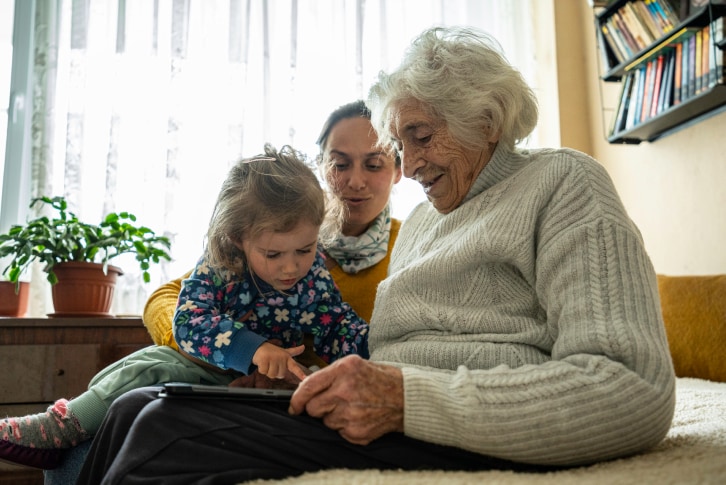Families in America are grappling with a daily struggle: balancing the care needs of their loved ones with work, rising costs, and mounting stress. They’re spending one-quarter (26%) of their income and devoting 26 hours a week to care responsibilities, all while their productivity at work diminishes by one-third on average as a result. I know you’ve heard about the child care crisis before–we’ve written posts about it ourselves–but here’s the thing: I’m not talking about child care in America. I’m talking about senior care in America.
Our care crisis isn’t confined to just the early years of life. It stretches across the entire spectrum of life and the challenges families face with senior care are just as real and demanding—yet far less discussed. We need to talk about it because we’re standing on the brink of an unprecedented demographic shift that has the potential to make matters much much worse. Before this simmering crisis bubbles over, we need to ask ourselves: What can we do about it?
The crisis at hand
To discuss solutions, we must first identify the problem. While the pandemic shone a spotlight on the deep rooted issue of care–both child and senior–following the closure of many facilities, the issue has not since been further prioritized, landing us back where we started. That’s a mistake that is going to come back to bite us. The U.S. Census Bureau projects that by 2034, older adults will outnumber children in the United States for the first time in history. This shift brings with it a significant increase in the demand for senior care, with a recent report by Wells Fargo estimating that an additional 1.7 million people will need some form of senior care within the next decade.
Yet, as this demand skyrockets, the supply of caregivers is shrinking. By 2030, the country is expected to face a shortage of 151,000 care workers, a number that could swell to 355,000 a decade later. This quickly translates into escalating costs and an ever-increasing burden on families, who are already struggling to manage the dual responsibilities of work and caregiving.
And like child care, this is not simply a personal or private problem–it’s a national crisis. As more family members take on senior caregiving tasks in the absence of accessible care, a ripple effect spreads throughout the economy. A Harvard Business School study found that caregivers–including parents, those caring for elderly family members, and those supporting a sick or disabled child, sibling, or spouse–comprise 73% of the workforce. When care responsibilities aren’t adequately supported, it leads to diminished productivity, costing employers an estimated $5,600 per employee annually.
Some employers are taking note of this and are recognizing the vital importance of senior care benefits. According to our most recent Future of Benefits Report, 50% of employers are prioritizing senior care benefits in 2024. These benefits not only support key employer goals like productivity, retention and recruitment but also foster a more inclusive workplace culture.
The government’s role in transforming senior care
But just as we’ve repeatedly stated with child care, solving for senior care isn’t just a responsibility for families and employers–it’s a national imperative that requires strong government action and a commitment from our elected officials.
The root of this crisis is clear: a growing demand for senior care paired with a dwindling supply of professional caregivers. To tackle this, we must start by reinvigorating the caregiving industry, making it a desirable profession that will attract new talent by offering competitive wages, benefits, and professional growth opportunities.
And just as the government must do more to make child care more affordable for families, they need to do more for those caring for seniors. Currently, family caregivers are overwhelmed with responsibilities, necessitating professional care, but they’re met with high costs that prevent them from seeking the help they need. While the cost varies depending on care arrangement, Genworth estimates families spend somewhere between $64k-$117k annually on average. With that, helping family and professional caregivers goes hand-in-hand: we need to create policies that make care more affordable without compromising the livelihoods of professional caregivers. Promising pieces of legislation like the Credit for Caring Act have been introduced to ease the financial burdens of care through a new tax credit. This kind of policy innovation is critical if we’re to balance the needs of families with the sustainability of the caregiving profession.
Calling care to action
We recently covered the cost of inaction with child care and what might have been if we’d only heeded the warning signs along the way. All the exact same signs are flashing right now with senior care. Imbalanced supply and demand; rising costs; shrinking workforces; negative economic impact. There is one big difference: while child care might not be an issue that directly touches every household, senior care is. We will all have aging loved ones, and hopefully, we will each live long healthy lives ourselves. That means this isn’t someone else’s problem. It’s everyone’s problem—and we need to start treating it as such.
How do we do that and how do we get this issue prioritized, especially during a busy election year? The first step is recognizing the power in our collective voice. Right now, there are approximately 62 million adults aged 65 and older, 37.1 million people providing unpaid senior care, and nearly 4.5 million professional senior care workers, making this an issue that affects nearly one-third of the U.S. population directly. This represents a powerful voting bloc with the potential to swing the pendulum for senior care. Pay attention when candidates talk about senior care…and press them if they don’t.
The challenge before us is significant but we have the opportunity to reimagine and rebuild our senior care infrastructure now, while it’s teetering, versus later when it has fully collapsed. We have the power to shape what aging in America will look like. I believe it should be a compassionate, affordable, accessible, and sustainable system. What about you? And remember, this will be your future too.






